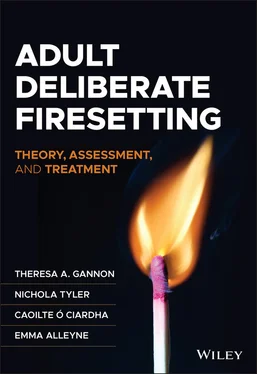Theresa A. Gannon - Adult Deliberate Firesetting
Здесь есть возможность читать онлайн «Theresa A. Gannon - Adult Deliberate Firesetting» — ознакомительный отрывок электронной книги совершенно бесплатно, а после прочтения отрывка купить полную версию. В некоторых случаях можно слушать аудио, скачать через торрент в формате fb2 и присутствует краткое содержание. Жанр: unrecognised, на английском языке. Описание произведения, (предисловие) а так же отзывы посетителей доступны на портале библиотеки ЛибКат.
- Название:Adult Deliberate Firesetting
- Автор:
- Жанр:
- Год:неизвестен
- ISBN:нет данных
- Рейтинг книги:5 / 5. Голосов: 1
-
Избранное:Добавить в избранное
- Отзывы:
-
Ваша оценка:
- 100
- 1
- 2
- 3
- 4
- 5
Adult Deliberate Firesetting: краткое содержание, описание и аннотация
Предлагаем к чтению аннотацию, описание, краткое содержание или предисловие (зависит от того, что написал сам автор книги «Adult Deliberate Firesetting»). Если вы не нашли необходимую информацию о книге — напишите в комментариях, мы постараемся отыскать её.
Explore the theoretical foundations of—and discover effective treatment options for—adults who deliberately set fires Adult Deliberate Firesetting: Theory, Assessment, and Treatment,
Adult Deliberate Firesetting: Theory, Assessment, and Treatment
Adult Deliberate Firesetting — читать онлайн ознакомительный отрывок
Ниже представлен текст книги, разбитый по страницам. Система сохранения места последней прочитанной страницы, позволяет с удобством читать онлайн бесплатно книгу «Adult Deliberate Firesetting», без необходимости каждый раз заново искать на чём Вы остановились. Поставьте закладку, и сможете в любой момент перейти на страницу, на которой закончили чтение.
Интервал:
Закладка:
The current literature is very limited in scope in terms of its examination of the sociodemographic characteristics of adults who set fires. However, based on what is currently available, adults who set fires do not appear to differ profoundly from the rest of the population apart from a clear predominance of men, a potentially higher prevalence among white individuals, and lower socio-economic status and educational attainment. Further research is needed that compares appropriate samples of adults who set fires to other justice involved individuals on basic demographic variables.
Developmental Context
Early factors—including genetic, biological, neurodevelopmental, and experiential factors—have been variously hypothesised as distal causal factors in adult firesetting. The results of Swedish population research (Frisell et al., 2011) suggests that there are genetic or early developmental influences on the commission of arson among those aged 15 years or older. To our knowledge, little additional research has been carried out to further determine the specific mechanisms through which genes may act on the psychological processes underpinning firesetting behaviour.
Research on neurobiological factors in firesetting has not advanced considerably since a review by Gannon and Pina (2010). Among the most promising research on the neurobiology of firesetting was research by Virkkunen and colleagues that implicated a role for certain neurotransmitters in distinguishing between people apprehended for arson and other offending groups as well as in predicting recidivism among people apprehended for arson (Virkkunen et al., 1987, 1989). Specifically examining the evidence of neurobiological characteristics for individuals who have set fires and have a mental disorder, Tyler and Gannon (2012) concluded that the literature is reliant on case studies or very small samples, limiting the conclusions that can be drawn.
Low IQ has been historically associated with adult firesetting. Nanayakkara et al. (2015) summarised the available evidence, concluding that while high rates of intellectual disability appeared to characterise some samples of individuals who have set fires, low IQ does not necessarily distinguish individuals who have set fires from other justice-involved individuals. A meta-analysis of four studies (predominantly adult samples) found that rates of intellectual disability among individuals with a history of firesetting appear to be less than 5% (Sambrooks et al., 2021; see also Collins et al., 2021 for a systematic review that also reports autism prevalence).
Gannon and Pina (2010) drew together literature suggesting that the developmental backgrounds of individuals who set fires are characterised by adversity. Specifically, they identified research (e.g., Bradford, 1982; McCarty & McMahon, 2005) implicating larger families, parental neglect, and sexual and physical abuse as factors differentiating young people and adults who set fires from other justice-involved individuals or from the wider population. In the decade since their review, very little research has examined whether the developmental experiences of people who set fires are markedly different to other groups. One exception is a paper by Ducat et al. (2013a), which compared a sample of men and women with convictions for firesetting offences with case files of randomly selected convicted individuals without firesetting histories. Both groups were characterised by childhood adversity but did not appear to differ meaningfully from one another. It is worth noting that there may be within-group variability in childhood adversity for people who have set fires, evidenced by the finding that individuals who set multiple fires may be characterised by greater physical and sexual abuse in childhood (Bell et al., 2018).
Taken together, the early lives of people who set deliberate fires in adulthood appear to be characterised by biological and experiential factors that differentiate them from the population of people who do not encounter the criminal justice system. There is also tentative evidence that genetic and neurobiological factors may differentiate people who set fires compared with those involved in other forms of criminality. There is less evidence of clear differences between the developmental experiences of people who set fires compared with other justice-involved individuals. Overall, the general picture of the developmental context of firesetting behaviour is of a literature that needs considerable updating with large robust studies.
Mental Disorder and Psychopathology
Firesetting behaviour has been consistently linked with mental ill health. The Multi-Trajectory Theory of Adult Firesetting (M-TTAF; Gannon et al., 2012) conceptualises mental health as a moderator of the link between causal factors and firesetting. In other words, mental ill health may exacerbate underlying risk factors to make firesetting more likely (see also McEwan & Ducat, 2016). This reflects a departure from some earlier views that presented a more direct, causal link between mental disorder and certain firesetting behaviour (e.g., Prins, 1994). Broadly speaking, the empirical research has focused on specific areas of mental disorder or psychopathology when it comes to a possible role in firesetting—pyromania, personality disorder, disorders involving psychosis, substance misuse, affective or mood disorders, and anxiety disorders.
Pyromania.Pyromania is perhaps the most obvious mental disorder to consider as linked to firesetting behaviour (and likely more causally than as a moderator). It is defined by multiple occasions of deliberate firesetting combined with tension or arousal prior to setting the fire and pleasure, gratification, or relief following setting the fire according to the fifth edition of the Diagnostic and Statistical Manual of Mental Disorders (DSM-5; American Psychiatric Association, 2013). Furthermore, there must be evidence of interest, curiosity, or attraction towards fire. However, there is little evidence of diagnostic utility of the concept of pyromania due to the number of exclusionary criteria included in the DSM (see Ó Ciardha et al., 2017). In fact, among populations of individuals apprehended for firesetting, a diagnosis of pyromania is extremely rare (e.g., Lindberg et al., 2005; Sambrooks et al., 2021). A key reason for the rarity of pyromania diagnoses is that DSM-5 exclusion criteria stipulate that firesetting should not be better accounted for by conduct disorder, mania, or antisocial personality disorder.
Personality disorders.The research examining personality disorders and firesetting has commonly implicated antisocial personality disorder as well as borderline personality disorder. Meta-analytic findings suggest that approximately one third of individuals apprehended for firesetting may have a personality disorder (Sambrooks et al., 2021). In summarising this literature, Nanayakkara et al. (2015; see also Tyler & Gannon, 2012) concluded that while antisocial personality disorder appears to characterise individuals who set fires (e.g., Lindberg et al., 2005; Repo et al., 1997; Vaughn et al., 2010)—and in particular those who use fire within a varied pattern of offending—borderline personality disorder and traits typically distinguish people apprehended for firesetting from other apprehended individuals (e.g., Ducat et al., 2013b; Duggan & Shine, 2001; Ó Ciardha et al., 2015a). Synthesising results across prison, secure mental health settings, and research on the wider population, personality disorder appears to be particularly characteristic of women who set fires when compared with men who have set fires and with other women (Alleyne et al., 2016; Hoertel et al., 2011; Nanayakkara et al., 2020a; Wyatt et al., 2019).
Psychosis.Psychosis and psychotic disorders (e.g., schizophrenia) have also been reported as comorbid with or otherwise linked with firesetting behaviour (Dickens & Sugarman, 2012; Nanayakkara et al., 2015; Sambrooks et al., 2021; Tyler & Gannon, 2012). Firesetting may even act as a marker for the subsequent onset of schizophrenia or schizoaffective disorder in some cases (Thomson et al., 2017). One of the most robust studies examining psychosis and a possible link with firesetting was carried out by Anwar and colleagues (2011) using a case-control design and a large sample of Swedish participants, including all individuals convicted of arson in a 13-year period. Both men and women with convictions for arson were more likely than population controls to have diagnoses of schizophrenia or other psychoses. Another well-powered study replicated the finding that there are differences between firesetting and community samples in terms of psychotic disorders, this time with a mixed-gender Australian sample (Ducat et al., 2013b). However, psychotic disorders did not differentiate individuals apprehended for firesetting from other justice-involved individuals in their sample, except when they looked specifically at schizophrenia, which was over-represented among individuals who had set fires. Using the NESARC US data, rates of self-reported diagnoses of psychotic disorders did not appear to be more prevalent among people with a history of firesetting compared with people without (Blanco et al., 2010; Vaughn et al., 2010). However, when split by gender (Hoertel et al., 2011), the same data indicated that women with a firesetting history were more likely to report psychotic disorder than women without. Psychosis and psychotic disorders also appear to be more strongly characteristic of women apprehended for arson compared with men apprehended for arson and women without firesetting histories (e.g., Anwar et al., 2011; Enayati et al., 2008).
Читать дальшеИнтервал:
Закладка:
Похожие книги на «Adult Deliberate Firesetting»
Представляем Вашему вниманию похожие книги на «Adult Deliberate Firesetting» списком для выбора. Мы отобрали схожую по названию и смыслу литературу в надежде предоставить читателям больше вариантов отыскать новые, интересные, ещё непрочитанные произведения.
Обсуждение, отзывы о книге «Adult Deliberate Firesetting» и просто собственные мнения читателей. Оставьте ваши комментарии, напишите, что Вы думаете о произведении, его смысле или главных героях. Укажите что конкретно понравилось, а что нет, и почему Вы так считаете.












